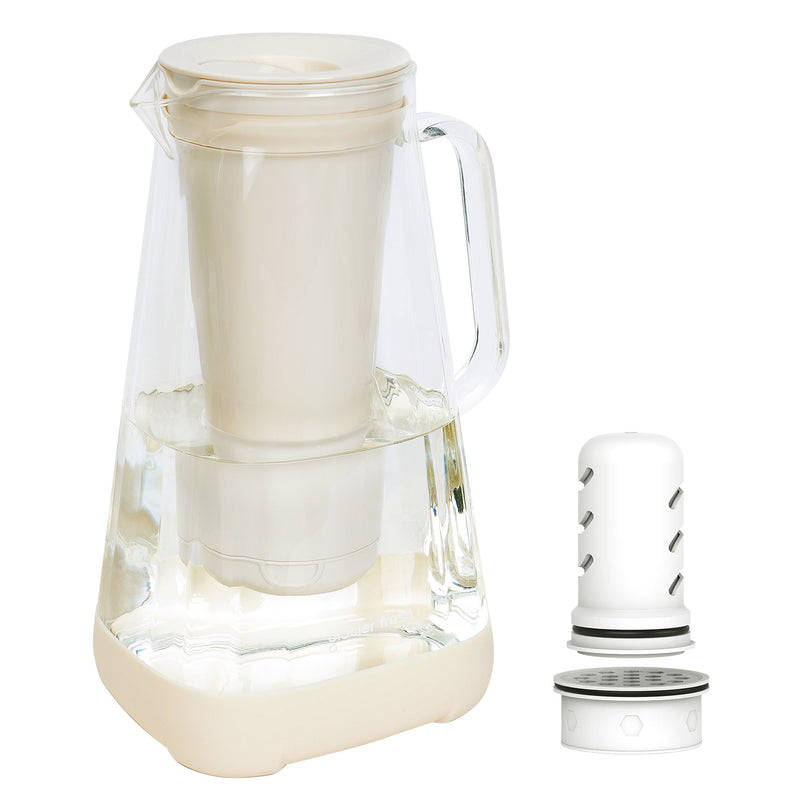Table of Contents:
Die Qualität von Brunnenwasser verstehen
Wie funktioniert Umkehrosmose?
Ist Umkehrosmose für Brunnenwasser sicher?
Zu berücksichtigende Faktoren vor der Installation eines RO-Systems für Brunnenwasser
Alternativen zur Umkehrosmose für Brunnenwasser
FAQs
Abschluss
Wenn Ihr Haushalt auf Brunnenwasser angewiesen ist, hat die Sicherheit Ihres Trinkwassers oberste Priorität. Brunnenwasser kann wertvoll sein, ist aber oft anfälliger für Verunreinigungen als kommunales Wasser. Viele Hausbesitzer setzen daher auf Filtersysteme wie die Umkehrosmose (RO), um ihr Wasser zu schützen. Aber ist eine Umkehrosmoseanlage die beste Wahl für die Aufbereitung von Brunnenwasser? In diesem Blogbeitrag erfahren Sie, ob die Verwendung von RO für Brunnenwasser sicher ist und was Sie vor dem Wechsel beachten sollten.
Die Qualität von Brunnenwasser verstehen

Brunnenwasser stammt aus unterirdischen Quellen, die auf natürliche Weise durch Erde, Steine und Sand gefiltert werden. Diese natürlichen Filter sind jedoch nicht narrensicher. Verschiedene Schadstoffe können in Ihre Wasserversorgung gelangen. Zu den häufigsten Schadstoffen im Brunnenwasser gehören:
- Bakterien und Viren : Schädliche Mikroorganismen aus nahegelegenen Klärgruben oder tierischen Abfällen können ins Wasser gelangen.
- Schwermetalle : Je nach Geologie der Region kommen im Grundwasser häufig Arsen, Blei und Quecksilber vor.
- Nitrate und Pestizide : Abwässer aus der Landwirtschaft, darunter Düngemittel und Pestizide, können eine erhebliche Gefahr für die Wasserqualität darstellen.
- Sediment : Schmutz, Sand und andere Partikel können das Wasser trüben.
Regelmäßige Wassertests sind unerlässlich, um diese Verunreinigungen zu erkennen und festzustellen, ob Ihr Brunnenwasser trinkbar ist. Ohne entsprechende Behandlung kann der Konsum von verunreinigtem Wasser zu ernsthaften Gesundheitsproblemen führen, insbesondere bei Menschen mit geschwächtem Immunsystem, Kindern und älteren Menschen.
Wie funktioniert Umkehrosmose?
Umkehrosmose (RO) ist ein weit verbreitetes Wasserfilterverfahren, bei dem Wasser durch eine semipermeable Membran gepresst wird. Diese Membran fängt Verunreinigungen auf und lässt nur saubere Wassermoleküle durch. Eine Umkehrosmoseanlage besteht typischerweise aus mehreren Stufen:
- Vorfilterung : Entfernt größere Partikel wie Sedimente und Chlor.
- Membranfiltration : Das Herzstück des Systems, wo gelöste Verunreinigungen herausgefiltert werden.
- Nachfiltration : Letzte Reinigung des Wassers, bevor es Ihren Wasserhahn erreicht.
Umkehrosmoseanlagen sind hochwirksam bei der Entfernung vieler Schadstoffe, darunter Schwermetalle (wie Blei und Arsen), Nitrate, Pestizide und bestimmte Chemikalien wie Fluorid Allerdings ist die Fähigkeit des Systems, Bakterien und Viren zu entfernen, begrenzt, sodass es als eigenständige Lösung für stark verunreinigtes Brunnenwasser ohne Vorbehandlung ungeeignet ist.
Ist Umkehrosmose für Brunnenwasser sicher?
Ja, Umkehrosmose ist im Allgemeinen sicher und effektiv für Brunnenwasser, es gibt jedoch einige Einschränkungen zu beachten. RO-Systeme sind besonders nützlich, um schädliche Verunreinigungen wie Schwermetalle , Nitrate und Pestizide zu entfernen, die häufig in Brunnenwasser vorkommen. Sie sind jedoch möglicherweise nicht ausreichend, wenn Ihr Wasser Bakterien, Viren oder andere Mikroorganismen enthält, die RO-Systeme nicht selbstständig effektiv herausfiltern können.
Brunnenwasser, das positiv auf biologische Verunreinigungen getestet wurde, muss vor der RO-Anlage mit einem Vorbehandlungssystem wie UV-Licht oder Chlorierung desinfiziert werden. Diese Kombination stellt sicher, dass Ihr Wasser frei von chemischen Schadstoffen und mikrobiologisch unbedenklich zum Trinken ist.
Zu berücksichtigende Faktoren vor der Installation eines RO-Systems für Brunnenwasser

Bevor Sie sich für das Umkehrosmosesystem Glacier Fresh für Ihr Brunnenwasser entscheiden, sollten Sie einige wichtige Faktoren berücksichtigen:
- Wassertest : Beginnen Sie mit einem umfassenden Wassertest, um die vorhandenen Verunreinigungen zu identifizieren. So können Sie feststellen, ob eine RO-Anlage allein ausreicht oder ob zusätzliche Filtermethoden erforderlich sind.
- Vorbehandlung : Um diese Mikroorganismen zu beseitigen, sollten Sie, falls Ihr Brunnenwasser Bakterien oder Viren enthält, zusätzliche Vorfilter- oder Desinfektionstechnologien wie UV-Licht oder Chlorierung in Betracht ziehen.
- Wartung : RO-Systeme erfordern regelmäßige Wartung , einschließlich Filterwechsel und Überprüfung der Membran, um eine optimale Leistung zu gewährleisten. Durch regelmäßige Wartung können Sie eine gute Filterung und sicheres Wasser erzielen.
- Systemkapazität : RO-Systeme produzieren Wasser langsam. Überlegen Sie daher, ob das System den Wasserbedarf Ihres Haushalts decken kann. Bei hohem Wasserverbrauch benötigen Sie möglicherweise ein System mit einem größeren Tank oder einer schnelleren Rückgewinnungsrate.
Alternativen zur Umkehrosmose für Brunnenwasser
Umkehrosmose ist zwar eine effektive Option, aber nicht die einzige. Je nach Ihren spezifischen Anforderungen an die Wasserqualität können andere Filtersysteme besser geeignet sein:
- Aktivkohlefilter : Diese Filter können einige organische Verbindungen, Chlor und Pestizide entfernen, sind jedoch weniger wirksam gegen Schwermetalle und Nitrate.
- UV-Filterung : Ideal zur Desinfektion von Wasser durch Abtötung von Bakterien und Viren. Chemikalien oder gelöste Feststoffe werden jedoch nicht entfernt.
- Hauswasserfilterung : Diese Systeme behandeln das gesamte Wasser, das in Ihr Haus gelangt, und sind nützlich, wenn Ihr Wasser mit einer Vielzahl von Schadstoffen verunreinigt ist. Sie können mit Umkehrosmosesystemen für eine umfassende Filterung kombiniert werden.
Jede Filtermethode hat Vor- und Nachteile, daher sollten Sie Ihre Wahl auf der Grundlage der Verunreinigungen in Ihrem Brunnenwasser treffen.
FAQs
Ist Umkehrosmose wirksam bei der Entfernung von Bakterien aus Brunnenwasser?
Nein, Umkehrosmose allein kann Bakterien und Viren nicht entfernen. Um mikrobiologisch unbedenkliches Wasser zu gewährleisten, benötigen Sie ein Vorbehandlungssystem , beispielsweise eine UV-Desinfektion.
Wie oft sollte ich mein Brunnenwasser mit einer Umkehrosmoseanlage testen?
Es wird empfohlen, Ihr Brunnenwasser mindestens einmal im Jahr zu testen, auch wenn Sie ein RO-System verwenden, um etwaige Änderungen der Wasserqualität zu überwachen.
Benötige ich einen Vorfilter für Brunnenwasser mit einem RO-System?
Ja, in den meisten Fällen sind Vorfilter erforderlich, um Sedimente und andere große Partikel zu entfernen, bevor das Wasser in das RO-System gelangt, wodurch die Lebensdauer des Systems verlängert wird.
Abschluss
Umkehrosmoseanlagen eignen sich hervorragend zur Filterung von Brunnenwasser, insbesondere zur Entfernung von Schwermetallen, Nitraten und Chemikalien. Sie sind jedoch keine Universallösung. Vor der Installation einer Umkehrosmoseanlage ist es wichtig, Ihr Brunnenwasser zu testen und zu prüfen, ob zusätzliche Filter, wie z. B. UV- oder Vorbehandlungsfilter, erforderlich sind. Mit der richtigen Einrichtung kann eine Umkehrosmoseanlage jahrelang sicheres, sauberes Trinkwasser aus Ihrem Brunnen liefern. Besuchen Sie Glacier Fresh für weitere Wasserfilterlösungen.
















